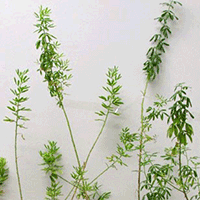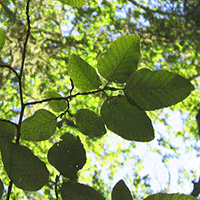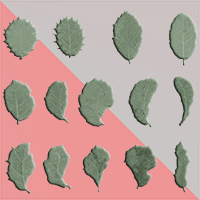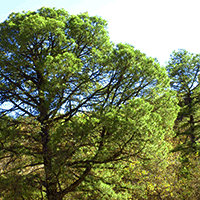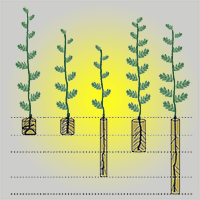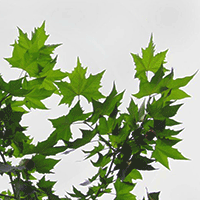Light is one of the most critical factors controlling tree survival and growth. Limited light availability induces phenotypic plasticity, thus enabling plants to adapt to suboptimal conditions. The plastic responses are species-specific and are thought to largely depend on species’ shade tolerance. This study aims to add to existing research by trying to disentangle the effects of light, species identity, and shade tolerance on growth, biomass partitioning, and morphology of seedlings of seven common European tree species. For that purpose, we set up a shading experiment where seedlings were grown under three levels of light availability (15%, 35%, and 100%). A destructive harvest was carried out for the assessment of biomass allocation and structural complexity of plant architecture after a year of exposure to limited light. The specific leaf area increased with decreasing light availability for all species. However, we found little to no changes in relative height and diameter growth, biomass allocation to aboveground tree compartments, and structural complexity along the light gradient. We argue that because trees were grown under open field conditions, both in the nursery and for the first year of the experiment, it might have resulted in a delayed response to limited light availability. Assuming the delayed reaction of less plastic plant organs, we expect that the morphological adaptations of the tree species and intra- and interspecific differences will become more pronounced, as the trees grow older.
Keywords
, , , , ,
Citation
Bebre I, Annighöfer P, Ammer C, Seidel D (2020). Growth, morphology, and biomass allocation of recently planted seedlings of seven European tree species along a light gradient. iForest 13: 261-269. - doi: 10.3832/ifor3370-013
Academic Editor
Claudia Cocozza
Paper history
Received: Feb 07, 2020
Accepted: May 05, 2020
First online: Jul 03, 2020
Publication Date: Aug 31, 2020
Publication Time: 1.97 months
© SISEF - The Italian Society of Silviculture and Forest Ecology 2020
Open Access
This article is distributed under the terms of the Creative Commons Attribution-Non Commercial 4.0 International (https://creativecommons.org/licenses/by-nc/4.0/), which permits unrestricted use, distribution, and reproduction in any medium, provided you give appropriate credit to the original author(s) and the source, provide a link to the Creative Commons license, and indicate if changes were made.

Breakdown by View Type
(Waiting for server response...)
Article Usage
Total Article Views: 40232
(from publication date up to now)
Breakdown by View Type
HTML Page Views: 33698
Abstract Page Views: 3199
PDF Downloads: 2614
Citation/Reference Downloads: 2
XML Downloads: 719
Web Metrics
Days since publication: 2006
Overall contacts: 40232
Avg. contacts per week: 140.39
Article Citations
Article citations are based on data periodically collected from the Clarivate Web of Science web site
(last update: Mar 2025)
Total number of cites (since 2020): 5
Average cites per year: 0.83
Publication Metrics
by Dimensions ©
Articles citing this article
List of the papers citing this article based on CrossRef Cited-by.
(1)
Annighöfer P, Petritan AM, Petritan IC, Ammer C (2017)Disentangling juvenile growth strategies of three shade-tolerant temperate forest tree species responding to a light gradient. Forest Ecology and Management 391: 115-126.
CrossRef |
Gscholar
(2)
Archibald S, Bond WJ (2003)Growing tall
vs. growing wide: tree architecture and allometry of
Acacia karroo in forest, savanna, and arid environments. Oikos 102: 3-14.
CrossRef |
Gscholar
(3)
Beaudet M, Messier C (1998)Growth and morphological responses of yellow birch, sugar maple, and beech seedlings growing under a natural light gradient. Canadian Journal of Forest Research 28: 1007-1015.
CrossRef |
Gscholar
(4)
Borges RM (2008)Plasticity comparisons between plants and animals: concepts and mechanisms. Plant Signaling and Behavior 3: 367-375.
CrossRef |
Gscholar
(5)
Bradshaw AD (1965)Evolutionary significance of phenotypic plasticity in plants. In: “Advances in Genetics”, vol. 13 (Caspari EW, Thoday JM eds). Elsevier, London, UK, pp. 115-155.
Online |
Gscholar
(6)
Canham CD, Berkowitz AR, Kelly VR, Lovett GM, Ollinger SV, Schnurr J (1996)Biomass allocation and multiple resource limitation in tree seedlings. Canadian Journal of Forest Research 26: 1521-1530.
CrossRef |
Gscholar
(7)
Chen HYH (1997)Interspecific responses of planted seedlings to light availability in interior British Columbia: survival, growth, allometric patterns, and specific leaf area. Canadian Journal of Forest Research 27: 1383-1393.
CrossRef |
Gscholar
(8)
Claveau Y, Messier C, Comeau PG, Coates KD (2002)Growth and crown morphological responses of boreal conifer seedlings and saplings with contrasting shade tolerance to a gradient of light and height. Canadian Journal of Forest Research 32: 458-468.
CrossRef |
Gscholar
(9)
Collet C, Chenost C (2006)Using competition and light estimates to predict diameter and height growth of naturally regenerated beech seedlings growing under changing canopy conditions. Forestry 79: 489-502.
CrossRef |
Gscholar
(10)
Delagrange S, Messier C, Lechowicz MJ, Dizengremel P (2004)Physiological, morphological and allocational plasticity in understory deciduous trees: importance of plant size and light availability. Tree Physiology 24: 775-784.
CrossRef |
Gscholar
(11)
Delagrange S, Montpied P, Dreyer E, Messier C, Sinoquet H (2006)Does shade improve light interception efficiency? A comparison among seedlings from shade-tolerant and -intolerant temperate deciduous tree species. The New Phytologist 172: 293-304.
CrossRef |
Gscholar
(12)
Delucia EH, Sipe TW, Herrick J, Maherali H (1998)Sapling biomass allocation and growth in the understory of a deciduous hardwood forest. American Journal of Botany 85: 955-963.
CrossRef |
Gscholar
(13)
Ellenberg H, Leuschner C (2010)Vegetation Mitteleuropas mit den Alpen in ökologischer, dynamischer und historischer Sicht [The Vegetation of Central Europe Including the Alps from an Ecological, Dynamic, and Historical Perspective]. 6, Auflage, UTB Botanik, Ökologie, Agrar- und Forstwissenschaften, Geographie. Verlag Eugen Ulmer, Stuttgart, Germany, pp. 1357. [in German]
Online |
Gscholar
(14)
Endara M-J, Coley PD (2011)The resource availability hypothesis revisited: a meta-analysis. Functional Ecology 25: 389-398.
CrossRef |
Gscholar
(15)
Givnish TJ (1988)Adaptation to sun and shade: a whole-plant perspective. Functional Plant Biology 15: 63-92.
CrossRef |
Gscholar
(16)
Gommers CMM, Visser EJW, St Onge KR, Voesenek LACJ, Pierik R (2013)Shade tolerance: when growing tall is not an option. Trends in Plant Science 18: 65-71.
CrossRef |
Gscholar
(17)
Hofmann R, Ammer C (2008)Biomass partitioning of beech seedlings under the canopy of spruce. Austrian Journal of Forest Science 125: 51-66.
Online |
Gscholar
(18)
Janse-Ten Klooster SH, Thomas EJP, Streck FJ (2007)Explaining interspecific differences in sapling growth and shade tolerance in temperate forests. Journal of Ecology 95: 1250-1260.
CrossRef |
Gscholar
(19)
Kozlowski TT, Pallardy SG (1997)Growth control in woody plants. Academic Press, San Diego, USA, pp. 641.
Online |
Gscholar
(20)
Lambers H, Chapin FS, Pons TL (2008)Plant physiological ecology (2nd edn). Springer, New York, New York, USA, pp. 604.
Gscholar
(21)
Lilles EB, Astrup R (2012)Multiple resource limitation and ontogeny combined: a growth rate comparison of three co-occurring conifers. Canadian Journal of Forest Research 42: 99-110.
CrossRef |
Gscholar
(22)
Mandelbrot BB (1982)The fractal geometry of nature. W. H. Freeman, San Francisco, CA, USA, pp. 460.
Gscholar
(23)
Messier C, Nikinmaa E (2000)Effects of light availability and sapling size on the growth, biomass allocation, and crown morphology of understory sugar maple, yellow birch, and beech. Écoscience 7: 345-356.
CrossRef |
Gscholar
(24)
Minotta G, Pinzauti S (1996)Effects of light and soil fertility on growth, leaf chlorophyll content and nutrient use efficiency of beech (
Fagus sylvatica L.) seedlings. Forest Ecology and Management 86: 61-71.
CrossRef |
Gscholar
(25)
Pacala SW, Canham CD, Silander Jr JA, Kobe RK (1994)Sapling growth as a function of resources in a north temperate forest. Canadian Journal of Forest Research 24: 2172-2183.
CrossRef |
Gscholar
(26)
Petritan AM, Von Lüpke B, Petritan IC (2009)Influence of light availability on growth, leaf morphology and plant architecture of beech (
Fagus sylvatica L.), maple (
Acer pseudoplatanus L.) and ash (
Fraxinus excelsior L.) saplings. European Journal of Forest Research 128: 61-74.
CrossRef |
Gscholar
(27)
Pham B, McConnaughay K (2013)Environmental selection and convergent evolution of plant phenotypes. In: “Ecology and the Environment” (Monson RK ed). Springer, New York, USA, pp. 1-20.
Gscholar
(28)
Poorter H, Niklas KJ, Reich PB, Oleksyn J, Poot P, Mommer L (2012)Biomass allocation to leaves, stems and roots: meta-analyses of interspecific variation and environmental control. The New Phytologist 193: 30-50.
CrossRef |
Gscholar
(29)
Poorter L (1999)Growth responses of 15 rain-forest tree species to a light gradient: the relative importance of morphological and physiological traits. Functional Ecology 13: 396-410.
CrossRef |
Gscholar
(30)
Pothier D, Prévost M (2002)Photosynthetic light response and growth analysis of competitive regeneration after partial cutting in a boreal mixed stand. Trees 16: 365-373.
CrossRef |
Gscholar
(31)
Prasad MNV (1997)Plant ecophysiology. John Wiley and Sons, New York, USA, pp. 542.
Gscholar
(32)
Reffye P, Houllier F, Blaise F, Barthelemy D, Dauzat J, Auclair D (1995)A model simulating above- and below-ground tree architecture with agroforestry applications. Agroforestry Systems 30: 175-197.
CrossRef |
Gscholar
(33)
Reich PB, Tjoelker MG, Walters MB, Vanderklein DW, Buschena C (1998)Close association of RGR, leaf and root morphology, seed mass and shade tolerance in seedlings of nine boreal tree species grown in high and low light. Functional Ecology 12: 327-338.
CrossRef |
Gscholar
(34)
Schall P, Lödige C, Beck M, Ammer C (2012)Biomass allocation to roots and shoots is more sensitive to shade and drought in European beech than in Norway spruce seedlings. Forest Ecology and Management 266: 246-253.
CrossRef |
Gscholar
(35)
Seidel D, Beyer F, Hertel D, Fleck S, Leuschner C (2011)3D-laser scanning: a non-destructive method for studying above- ground biomass and growth of juvenile trees. Agricultural and Forest Meteorology 151: 1305-1311.
CrossRef |
Gscholar
(36)
Seidel D (2018)A holistic approach to determine tree structural complexity based on laser scanning data and fractal analysis. Ecology and Evolution 8: 128-134.
CrossRef |
Gscholar
(37)
Seidel D, Annighöfer P, Stiers M, Zemp CD, Burkardt K, Ehbrecht M, Willim K, Kreft H, Hölscher D, Ammer C (2019a)How a measure of tree structural complexity relates to architectural benefit-to-cost ratio, light availability, and growth of trees. Ecology and Evolution 9: 7134-7142.
CrossRef |
Gscholar
(38)
Seidel D, Ehbrecht M, Dorji Y, Jambay J, Ammer C, Annighöfer P (2019b)Identifying architectural characteristics that determine tree structural complexity. Trees 33: 911-919.
CrossRef |
Gscholar
(39)
Sevillano I, Short I, Grant J, O’Reilly C (2016)Effects of light availability on morphology, growth and biomass allocation of
Fagus sylvatica and
Quercus robur seedlings. Forest Ecology and Management 374: 11-19.
CrossRef |
Gscholar
(40)
Shipley B, Meziane D (2002)The balanced-growth hypothesis and the allometry of leaf and root biomass allocation. Functional Ecology 16: 326-331.
CrossRef |
Gscholar
(41)
Valladares F, Chico J, Aranda I, Balaguer L, Dizengremel P, Manrique E, Dreyer E (2002)The greater seedling high-light tolerance of
Quercus robur over
Fagus sylvatica is linked to a greater physiological plasticity. Trees 16: 395-403.
CrossRef |
Gscholar
(42)
Valladares F, Gianoli E, Gómez JM (2007)Ecological limits to plant phenotypic plasticity. The New Phytologist 176: 749-763.
CrossRef |
Gscholar
(43)
Valladares F, Niinemets U (2008)Shade tolerance, a key plant feature of complex nature and consequences. Annual Review of Ecology, Evolution, and Systematics 39: 237-257.
CrossRef |
Gscholar
(44)
Van Couwenberghe R, Gégout J-C, Lacombe E, Collet C (2013)Light and competition gradients fail to explain the coexistence of shade-tolerant
Fagus sylvatica and shade-intermediate
Quercus petraea seedlings. Annals of Botany 112: 1421-1430.
CrossRef |
Gscholar
(45)
Van Der Zande D, Jonckheere I, Stuckens J, Verstraeten WW, Coppin P (2008)Sampling design of ground-based lidar measurements of forest canopy structure and its effect on shadowing. Canadian Journal of Remote Sensing 34: 526-538.
CrossRef |
Gscholar
(46)
Walters MB, Reich PB (1996)Are shade tolerance, survival, and growth linked? Low light and nitrogen effects on hardwood seedlings. Ecology 77: 841-853.
CrossRef |
Gscholar
(47)
Welander NT, Ottosson B (1998)The influence of shading on growth and morphology in seedlings of
Quercus robur L. and
Fagus sylvatica L. Forest Ecology and Management 107: 117-126.
CrossRef |
Gscholar
(48)
Zhang L, Copini P, Weemstra M, Sterck F (2016)Functional ratios among leaf, xylem and phloem areas in branches change with shade tolerance, but not with local light conditions, across temperate tree species. The New Phytologist 209: 1566-1575.
CrossRef |
Gscholar


